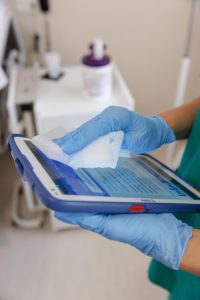 “Why”
“Why”
Healthcare professionals are at the front-line of patient care, ensuring safety through infection control. The Centers for Disease Control & Prevention advise, “Cleaning is the necessary first step of any sterilization or disinfection process.”
Providing healthcare professionals with traditional data collection hardware is not enough.
The CDcleaning barcode scannerC’s “Guidelines for Environmental Infection Control in Health Care Facilities” reiterate, ‘cleaning and disinfecting environmental surfaces as appropriate is fundamental in reducing their potential contribution to the incidence of healthcare-associated infections.’
There is a current trend towards the use of antimicrobial impregnated materials in healthcare products. These products are marketed as inhibiting the growth of mold and bacteria on the product’s surface for the life of the product.
Anti-Microbial’ is Not Enough – Data Collection Hardware Still Needs to be Cleaned… Learn more, download a PDF.
“How”
Recommended Cleaning Solutions:
Honeywell Scanning and Mobility Devices
- Sani-Cloth® HB
- Sani-Cloth® Plus
- 409® Glass and Surface Cleaner
- CaviWipesTM
- Clorox® Bleach – 100%
- Gentle Dish Soap and Water
- Virex® 256
- Windex® Blue
- Isopropyl Alcohol Wipes (70%)
- Super Sani-Cloth®
Motorola / Zebra Technology Handheld Devices
- Ethanol 80%
- Clorox® Bleach – 100%
- Dispatch®
- Super Sani-Cloth® Wipes
- Clorox® Bleach – 100%
- Gentle Dish Soap and Water
- Virex® 5
- Windex® with Ammonia D
- Windex® with Antimicrobial
Can these Chemicals Damage my equipment? Check with your supplier.
Before you get the unit wet find out your IP Rating. What is an IP rating?
The degrees of protection are most commonly expressed as “IP” followed by two numbers, e.g. IP65, where the numbers define the degree of protection. The first digit (Foreign Bodies Protection) shows the extent to which the equipment is protected against particles, or to which persons are protected from enclosed hazards. The second digit (Water Protection) indicates the extent of protection against water. The wording in the table is not exactly as used in the standards document, but the dimensions are accurate. Recommend IP X 3 (3 or higher).